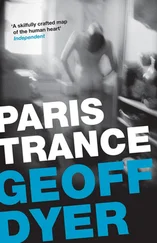“There’s Lazy S.,” says Nietfeldt. His eyes are wide with excitement and his voice is unusually high. He reaches out and grasps his partner’s forearm and gives it a light squeeze. “There’s Susan.”
“Holy shit,” says Langmo. “Finally a break. You think she’s alone in there?”
“Doubt it. Manager says they’re painting two apartments a day. There’s got to be at least a couple of them.”
The young woman tosses her cigarette to the ground and returns to the apartment, closing the door behind her.
“Better call it in.”
“Fucking A.” Nietfeldt picks up the radio.
At 5:30 Susan and a young man leave the apartment. Langmo flips through the bundle of photos the agents carry.
“Who you think? Jeff?”
“He’d be the logical one.”
The man climbs into the driver’s seat and starts up the Ford. Revolutionaries or not, men like to do the driving. Nietfeldt allows the Ford to leave the lot before he follows. He noses out into traffic and watches as it heads toward the on-ramp for 280 North, then follows the car onto the freeway, tailing it at a distance.
“They’re staying in the right lane,” observes Langmo.
“Probably getting onto three-eighty.”
The interchange comes up but the Ford keeps heading north on 280. Nietfeldt steers the sedan into the lane that will channel them onto 380, a spur that cuts across the Peninsula, linking 280 with the airport and the Bayshore Freeway to the east. Polhaus has positioned several cars along likely routes to be able to pick up the Ford at any point on its journey.
“Well, we’re out of it,” Nietfeldt says.
They approach the raw brown hills just below the city, on one of which letters spell out the announcement:
SOUTH
SAN FRANCISCO
THE INDUSTRIAL CITY
Nietfeldt remembers when the letters were whitewashed onto the hill, surrounded by colorful wildflowers. The idea was to give the sign the look of a sampler that had been embroidered by some old industrial granny, patient in her industrial rocker. He remembers it aloud, as usual. Langmo looks out the passenger side window and surreptitiously rolls his eyes. Now the letters are of poured concrete, concludes Nietfeldt. As usual. Five feet high.
They round a curve and suddenly the manufacturing and warehouse topography on their right drops away and the bay is brilliant there. Up ahead is Candlestick, not so brilliant. Hereabouts the radio burbles, and Langmo grabs it. Turns out they’re back in it. Code Three call. Exit 101 at Army and wait at Army and South Van Ness.
They ease to the curb at a bus stop before a low-rise housing project. An old armchair with one broken leg sits propped up on the sidewalk, and a man in faded fatigues sleeps in it, a near-empty bottle of Cisco (“Takes You by Surprise”) cradled in his arms. Langmo radios in their position.
Soon they see the Ford rolling down the hill toward them, stopping for the light at Mission, signaling a right turn. Nietfeldt pulls into traffic, turns left onto Mission, and eases up to the curb outside Cesar’s Palace, a nightclub. Langmo begins to drum softly, a Latin-type beat, on the dashboard.
“Ever been here?” he asks. Nietfeldt just looks at him.
The Ford draws abreast of them and comes to a stop. Nietfeldt feels the hair prickle up on the back of his neck. The last thing he wants is to be shot sitting in his car outside a Mexican dance hall. He hazards a quick look out his window. Susan Rorvik is talking and sipping from a straw stuck in a big paper cup. The cup says “COLD Drink,” and icicles have formed on the letters of the word COLD. Brrrr. Abruptly the car turns left onto a narrow side street. Precita.
“Jesus,” says Langmo, “that’s a one-way street.”
“Once a cop,” says Nietfeldt. Langmo was an Oakland patrolman for three years before joining the Bureau.
“After them!” says Langmo, affecting a theatrical baritone.
They radio in the Ford’s position and proceed cautiously up Precita. Shortly they arrive at a narrow wedge of park that effectively forks the road, but they can see the Ford, still pointed in the wrong direction, parked up ahead and to the left on Precita.
“Dumb-ass,” says Nietfeldt. He takes the right fork, intending to turn around so that he’s traveling with the traffic, but this turns out to be a mistake, and they wind through the hilly streets of Bernal Heights for a few minutes, looking to pick up Precita again, turning left onto it just in time to see the Ford finish executing a broken U-turn and head back the way it had come. The unidentified man still drives, but he’s alone now.
“She lives here,” says Nietfeldt confidently. 200 block. He picks up the radio; let someone else chase the Ford for a while. Lazy S. is here. Herself: right here.
10 p.m.
“Ever figure out your secret name?” asks Nietfeldt. He holds a burrito in both hands, its lower half wrapped in a thin sheet of aluminum foil. A strawberry drink sits before him on the dash.
“What’s that?”
“Take your middle name and the street you lived on last. That’s your secret name.” He takes a bite and chews, nodding. “Or it can be your confirmation name plus the street you grew up on. But I like it the other way. It changes more often.”
“What the hell do you do it for?” Langmo eats like a ravening beast, and his supper is long gone, the aluminum sheet stuffed into the empty paper cup on the floor. Nietfeldt eats slowly, partly from habit, partly to irritate his partner.
“For fun, you dummy.”
“OK. What’s yours?”
“Charles Lisbon. I’m actually cheating. The very last place I lived was out on Twenty-fifth Avenue.”
“That is cheating.” Langmo is irritable.
“Never even heard of it two minutes ago and now he’s telling me the rules.”
“If that’s what it is, that’s what it is.”
“The expert.”
“Anyway, I don’t get what the problem you have with it is. Charles the Twenty-fifth. Sounds positively royal.”
“There were only two Charleses. So what’s yours then?”
Langmo drags furiously on his cigarette and stubs it out in the packed ashtray. “Xavier Moraga,” he says, finally.
Polhaus has a San Francisco map tacked to the wall and he stands before it, a ruler and a pack of felt-tip pens in his hands. Holding the ruler in place against the map, he carefully draws a yellow line around the San Bruno complex. Then he draws a red line along the 200 block of Precita. Finally, he places an orange line along the 600 block of Morse Street. This last is way the hell out there, far from Postcard San Francisco, the Outer Mission or the Ingleside or something. Not a neighborhood he knows. Agents Bockenkamp and Protzman followed the Ford from Precita to this location. Its driver went into the house at number 625, entering through the door leading to the upstairs flat. Lights were already on up there. Tentatively, they made the man as Roger Rorvik. They waited until after the lights had gone out upstairs and then called it in.
The agents wander in, looking red-eyed, vaguely unkempt, but ready for his spiel. It’s muted, but Polhaus senses anticipatory zeal in the room. They’re days away, maybe hours. It isn’t just the Rorviks trundling around. Sooner or later whoever else it is will show themselves. Nobody comes to San Francisco just to stay indoors. If they’re here, it’s because they were dying to get back into circulation. Sooner or later they’ll come out. He’s willing to bet that they’ve been biding time in one shitheel town after another, all downhill from South Canaan. His guess is that the Precita place is the central location. Hence his candy red mark on the map. He is certain. He is so certain that his plans include round-the-clock surveillance at Precita, but no check of the job site in San Bruno and only occasional drive-bys at Morse Street.
Читать дальше












